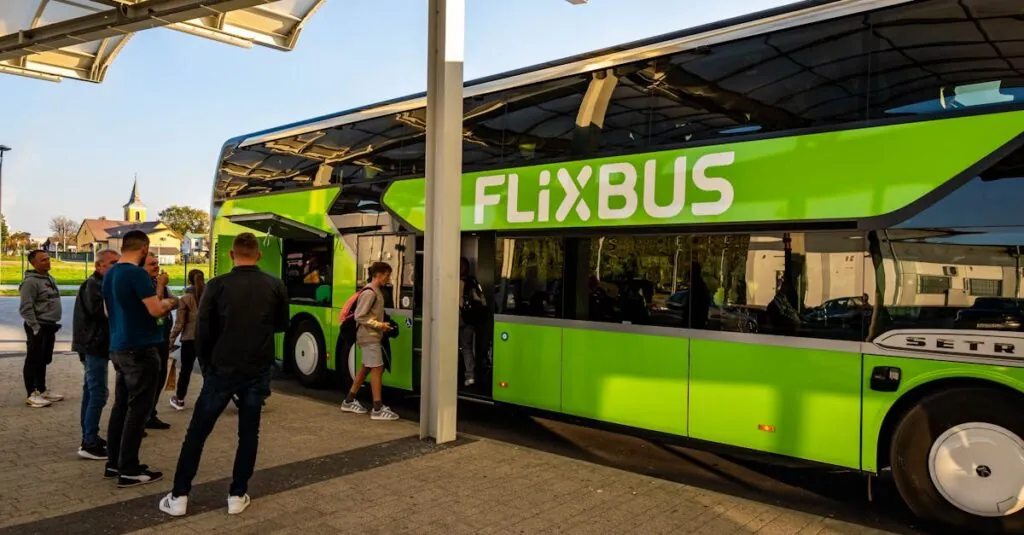Table of Contents
ToggleImagine a world where getting from point A to point B doesn’t involve a car, a bike, or a pair of rollerblades that you secretly hope won’t send you flying into a bush. Welcome to the bus network—your trusty steed in the wild jungle of urban transportation. It’s not just about hopping on a bus; it’s about embracing a lifestyle that’s eco-friendly, wallet-friendly, and maybe even a little adventure-friendly.
Overview of Bus Networks
Bus networks consist of interconnected routes designed to facilitate efficient transportation for urban and rural areas. Each route serves specific neighborhoods, providing commuters with access to key destinations. Many cities utilize various types of buses including local, express, and commuter services.
Flexibility remains a significant advantage of bus networks. Buses often operate on schedules and can adjust routes based on demand during peak times. Riders can rely on real-time tracking apps to monitor bus locations and estimated arrival times.
Efficiency in bus networks enhances urban mobility. According to the American Public Transportation Association, public transit can reduce traffic congestion by as much as 45 percent in metropolitan areas. Notably, this reduction contributes to improved air quality, making bus networks environmentally friendly options.
Affordability also plays a crucial role in the appeal of bus services. While operating costs are lower than those associated with personal vehicles, bus fares typically remain budget-friendly, encouraging more individuals to choose public transit over driving.
Many successful bus networks implement integrated systems. Integration with subways and light rail services allows for seamless transitions between different modes of transportation. This convenience promotes higher ridership as commuters find it easier to navigate their journeys.
Comprehensive bus networks provide essential services that support sustainable urban living. They connect communities, reduce environmental footprints, and offer affordable public transit solutions. Enhanced connectivity through bus networks fosters economic growth while enriching the daily lives of commuters.
Importance of Efficient Bus Networks
Efficient bus networks play a crucial role in modern urban transportation systems. They provide essential connectivity, enhance mobility, and support sustainable development.
Accessibility and Coverage
Accessibility defines an effective bus network’s success. Bus services reach underserved areas, ensuring that all communities gain access to jobs, education, and healthcare. Coverage across urban and rural regions also promotes inclusivity. By decreasing travel times, buses connect people to essential services quickly. Transportation equity grows when diverse populations can rely on public transit options. Statistics indicate that increased coverage can raise ridership by 20 percent or more, fostering public engagement and satisfaction.
Environmental Impact
Environmental impact matters significantly for sustainable transportation. Buses emit fewer greenhouse gases than personal vehicles, drastically lowering urban pollution levels. Public transit reduces individual car trips, which contributes to decreased traffic congestion by up to 45 percent. Cleaner air results from fewer emissions, positively impacting public health. Additionally, efficient bus networks encourage modal shifts, as riders often choose buses over personal cars. With sustainable practices, cities can aim for long-term reductions in their carbon footprints.
Types of Bus Networks
Bus networks primarily fall into two categories: urban and intercity. Understanding these types helps clarify their unique roles in transportation.
Urban Bus Networks
Urban bus networks focus on city transportation. They consist of numerous routes designed to cover densely populated areas. High-frequency service allows for quick and convenient travel. Routes adapt to peak demand, ensuring timely transportation for commuters. Accessibility remains crucial, with stops located near key destinations like schools and hospitals. Real-time tracking enhances user experience, allowing riders to plan their journeys effectively. Statistics show that urban bus services can decrease traffic congestion significantly, which contributes to better air quality in cities.
Intercity Bus Networks
Intercity bus networks connect cities and towns over longer distances. These networks offer service between urban centers and suburban areas. Affordability remains a major advantage, with fares typically lower than train or air travel. A range of schedules accommodates varying travel needs, making intercity buses a viable option for many. Furthermore, intercity services often operate on established highways, providing efficient travel routes. Statistics indicate that intercity buses can reduce carbon footprints compared to cars, promoting greener travel alternatives. Comfort-focused amenities, such as Wi-Fi and reclining seats, enhance the overall travel experience for passengers.
Challenges Facing Bus Networks
Bus networks face several significant challenges that impact their efficiency and effectiveness. Common issues involve infrastructure limitations and funding constraints, which can hinder service delivery and expansion.
Infrastructure Limitations
Inadequate infrastructure often affects bus networks, leading to service inefficiencies. Roads may require upgrades or maintenance, directly influencing route reliability. Insufficient bus stops can create accessibility barriers for passengers, resulting in reduced ridership. Moreover, lack of dedicated bus lanes contributes to delays caused by mixed traffic conditions, making schedules unpredictable. Consequently, addressing these infrastructural shortcomings is essential for enhancing the overall performance of bus networks.
Funding and Budget Constraints
Funding challenges significantly limit bus network operations. Many transit agencies operate under tight budgets, restricting their capacity to invest in new technologies and upgrade services. Insufficient financial resources can result in fewer routes and reduced frequency, ultimately deterring potential riders. Additionally, competition for municipal funding exacerbates the issue, as resources may favor other transportation sectors. Ultimately, consistent and stable funding is crucial for enabling bus networks to thrive and expand their reach.
Innovations in Bus Network Design
Innovations in bus network design significantly shape urban mobility. They incorporate advanced technology and efficient systems to enhance rider experiences.
Smart Bus Systems
Smart bus systems transform travel by utilizing real-time data for efficient operations. These systems allow passengers to receive updates on bus arrival times, improving overall satisfaction. Cities incorporating smart technology have noticed increased ridership, with some areas reporting boosts of up to 30 percent. The integration of GPS tracking enables transit agencies to optimize routes based on demand, minimizing delays. Enhanced communication systems ensure that riders stay informed about service changes, contributing to a smoother commuting experience.
Integrating Technology
Integrating technology into bus networks streamlines operations and augments customer engagement. Mobile apps provide features such as trip planning, fare purchasing, and service alerts, making public transportation more accessible. Moreover, automated fare collection systems expedite the boarding process, reducing wait times at stops. Data analytics play a crucial role in identifying patterns and improving service frequency during peak hours. By leveraging technology, bus networks create efficient, user-friendly experiences that increase the appeal of public transit in urban settings.
Conclusion
Bus networks are vital for modern urban transportation. They offer a sustainable and accessible alternative to personal vehicles while enhancing connectivity within communities. As cities continue to grow, the importance of efficient bus systems becomes even more pronounced.
Innovations in technology play a crucial role in improving rider experiences and operational efficiency. By addressing infrastructure challenges and ensuring stable funding, cities can maximize the benefits of bus networks. This commitment not only supports economic growth but also fosters a healthier environment.
Ultimately, embracing and investing in comprehensive bus networks paves the way for smarter and greener urban living.




